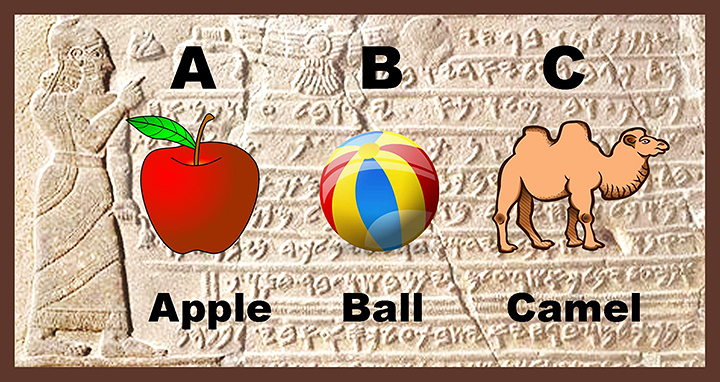
A rodeo rider’s introduction to alphabetic writing systemsCOFFEE WITH WARREN, with Warren Harbeck |

|
The long journey toward the ABC’s taught to primary grades students in the West today began with the development of alphabetic writing in the Ancient Near East some 3,500 to 4,000 years ago. The late Jimmy Kaquitts, of Morley, Stoney Nakoda rodeo rider and humorist, loved to tell the story of his first day in school. “I entered the classroom, and there all across the wall above the blackboard were these pictures of all kinds of plants, animals, and other things,” he said, referring to the illustrated alphabet cards. “The first picture was of an apple and the second picture was of a ball,” he recalled. “But the third picture was the weirdest thing you ever did see. I never saw anything like it before. It looked like a horse that had swallowed its saddle!” This was his introduction to the letter “C” – and to the camel, that legendary animal so associated with the Middle East where our alphabet was born. Which brings me to a conversation I had recently with our grandson Thomas Harbeck. He’s normally into international development issues, but this time he couldn’t wait to share with me his growing fascination with a different kind of development, of special interest to his linguist Grandpa – the development of our alphabet. I asked him why he thought this topic was so important. “I think writing and writing systems are important to me because they allow us to communicate and to learn,” he said. “More specifically with the history of writing, I find it interesting because writing systems reveal to us who we are and where we come from. “The history of written language follows the history of human civilization, from the first written languages of Sumer (cuneiform) and Egyptian (hieroglyphs) to their descendants, including Semitic writing systems (Akkadian, Assyrian and Babylonian from Sumerian) and especially the Proto-Sinaitic that emerged from Egyptian somewhere around 1800BC-1200BC.” Thomas noted especially the Phoenician and Aramaic alphabets which underlie the writing of Hebrew and Greek, and subsequently of Latin and English, reflected in the alphabet chart Jimmy encountered on his first day in school. So, just what is it that distinguishes our alphabetic writing system from the other systems of the Ancient Near East? Whereas systems such as Egyptian hieroglyphs had separate symbols (ideograms) to refer to each separate thing – much like our modern use of an image of a heart to refer to “love” --, the Phoenician and Aramaic writing systems made use of sound-based symbols. If you could say a word, you could write it, sound by sound. For some of those alphabets, only consonants were indicated – much as we do in English when abbreviating words, such as “vctn” for “vacation” or “nwsppr” for “newspaper.” But it soon became apparent that adding symbols for vowels would greatly improve matters, eliminating such ambiguities as whether, in English, “tp” is to be pronounced “tip,” “tap” or “top.” Thus, Greek has the vowel letter alpha (a), as well as the consonant beta (b), from which we get the word “alphabet.” And therefore also the alphabet chart in Jimmy’s classroom: A is for Apple, B is for Ball – and yes, for the horse that looked like it had swallowed its saddle, C is for Camel.
© 2018 Warren Harbeck |